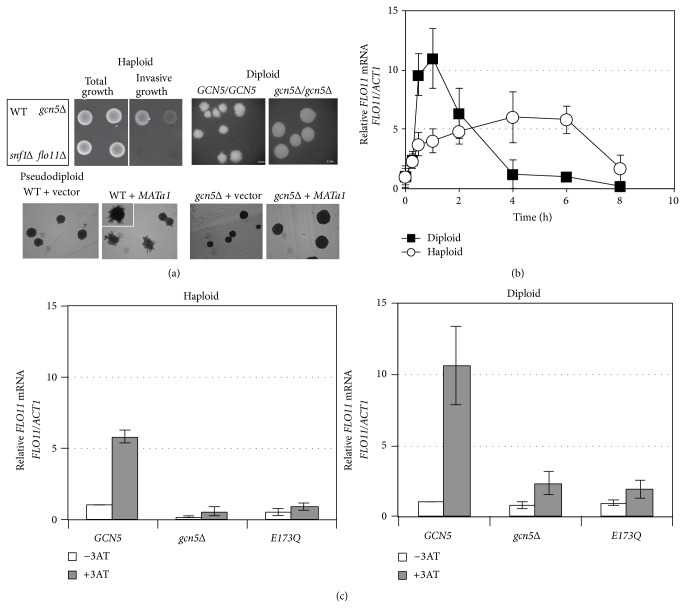Figure 1.
Gcn5 is involved in pseudohyphal development and FLO11 expression. (a) Gcn5 is required for invasive growth in haploids and filamentous growth in diploids. Haploid cells of wild type (WT) yeast and deletion mutants (gcn5Δ, snf1Δ, and flo11Δ) were grown on YPD agar medium for 4 d at 30°C before analyzing invasive growth (haploid, top left panel). Cells grown on agar surface before (total growth) and remaining after being rinsed with water (invasive growth) are shown. The WT (GCN5/GCN5) and homozygous gcn5Δ diploids (gcn5Δ/gcn5Δ) were grown on nitrogen starvation agar medium (SLAD) for 6 d at 30°C before filamentous growth was recorded (diploid, top right panel). Shows filamentous growth of colonies on SLAD agar medium for diploid WT (GCN5 + vector) and gcn5Δ (gcn5Δ + vector) and pseudodiploid WT (GCN5 + Mat a1) and gcn5Δ (gcn5Δ + Mat a1) (pseudodiploid, bottom panel). Scale bar: 0.5 mm. (b) The expression patterns of FLO11 in haploid and diploid yeast in response to 3AT. The isogeneic haploid and diploid strains were grown at 30°C in minimal medium to 0.8 OD600 (time 0) and induced with 10 mM 3AT. Total RNA was prepared from samples collected at the times indicated. Quantitative RT-PCR (RT-qPCR) analysis of the mRNA levels of FLO11 normalized to that of ACT1. (c) The histone acetyltransferase activity of Gcn5 is required for induced FLO11 expression by 3AT. Total RNA was prepared from samples collected at 2 h (haploid) or 1 h (diploid) after the addition of 3AT. The gcn5 deletion haploid (left panel) or diploid (right panel) strains carrying a wild type GCN5 (GCN5), vector (gcn5Δ), or a catalytic dead mutant (E173Q) were grown in repressed (−3AT) or induced condition (+3AT, 10 mM). RT-qPCR analysis of the mRNA levels of FLO11 normalized to that of ACT1 and compared with the WT (GCN5) without 3AT. Data are mean ± SD from 3 biological repeats ((b)-(c)).

